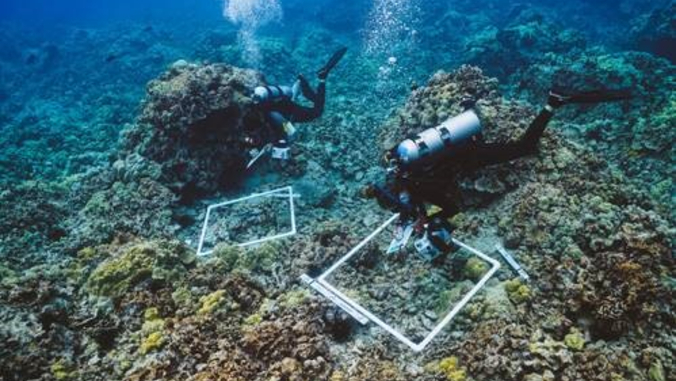
Collaborative coral study compares old, new scientific techniques

Students from the UH Hilo ʻIke Wai Summer Research Experience survey coral health and collect imagery for 3D reconstruction on coral reefs off the Kona coast.
Students and faculty in the ʻIke Wai Research Experience in Data Science Program at the University of Hawaiʻi at Hilo had their work on coral health and disease published in Frontiers Marine Science on May 6.
The publication, “A Comparison of the Diagnostic Accuracy of in-situ and Digital Image-Based Assessments of Coral Health and Disease,” is the result of research done in summer 2019.
The study addresses a pressing issue of the capability of digital images to be used for detecting disease in marine environments and provides the pros and cons of using new technologies versus conventional techniques.
The students conducted underwater conventional coral health surveys and collected imagery for high-resolution 3D models of the same study plots for comparison. The findings showed that the human visual assessment is more sensitive for detecting disease than the digital approach, though it can be a useful tool when human divers cannot safely access reef habitats for visual surveys.
“This project was a close collaboration between students and faculty in marine science, computer science (CS) and mathematics,” said Grady Weyenberg, assistant professor of mathematics. “Everybody got to learn a bit about how marine scientists conduct coral surveys, the CS problems involved in building 3D models from photographs and the math modeling and computation that goes into more advanced Bayesian statistical models.”
“This was a really great example of advancing science in an interdisciplinary manner,” added John H.R. Burns, assistant professor of marine science. “To me, this project and resulting paper really capture one of the main goals of the UH Hilo Data Science program, which is bringing together students from multiple disciplines to conduct exciting applied research.”
The students involved in the publication include marine science students Sofia Ferreira, Shane Murphy, Alexandra Runyan, Alexander Spengler, Brittany Wells and Danielle Wilde; computer science students Drew Gotshalk, Chad Kinoshita and Nicholas Del Moral; mathematics student Micah Marshall; and Kailey Pascoe, a tropical conservation biology and environmental science student.
Faculty members Burns, Weyenberg and Travis Mandel from computer science co-authored the paper alongside the students.
Read the full paper at Frontiers Marine Science.
—By Alyson Kakugawa-Leong
